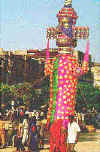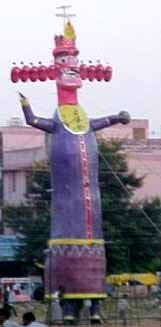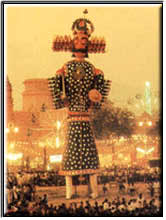|
Link Back To Madhu's Home Page
Link Back To Hindu Festivals
Link Back To Durga Puja
Link Back To Navratri
Dushehra celebrates the victory of good over evil as depicted in Ramayan. According to the
epic Ramayan, Lord Ram Chandra was the crown prince of Ayodhya who was banished to the forest for 14 years through trickery
by his step-mother who wanted the throne for her own son Bharat. Ram's wife Seeta and brother Lakshman accompanied him
on his exile. While living in the forest, Seeta was abducted by Ravan, the demon king of Lanka. Ram prayed to Goddes
Durga also knwn as Shakti (power) before attacking Lanka to rescue Seeta.
Ram and Lakshman lead an army of monkeys and other animals while Ravan had a well trained powerful army. A fierce battle ensued
between the two armies for 10 days. Ravan had a boon that enabled him to grow back a head after it was cut off, so it was
proving very difficult to beat the mighty Ravan. Finally Ram was able to kill Ravan by shooting an arrow at a vulnerable part
of his body. The name Dushehra comes from the 10 heads of Ravan (dus =10, hara = stolen / conquered). The scenes
from the Ramayan are enacted in a folk art form called Ram Lila (Miracles of Ram). The whole story of Ram's life is acted
out in 10 days. The tenth day marks the end of Ram Lila when the final act of this drama is staged. Huge effigies, sometimes
almost 100 ft high, of Ravan, his son Meghnad and his brother Kumbhkaran are made many days in advance. They are stuffed
with hay and fire crackers. At the appointed time, a person dressed as Ram, shoots flaming arrows at the effigies, which start
to burn. Shouts of 'Jai Shri Ram’ or 'Hail Lord Ram' resound. People compete with each other to make bigger and better
effigies and as they burn, the hidden fireworks begin.
This tenth day is better known as ‘Vijay Dashmi’ since ‘Vijay’ means
victory and ‘Dashmi’ means the tenth. Dushehra is celebrated with a great deal of enthusiasm over a period
of ten days and is an occasion of revelry for all. It is a time for new clothes, fun, dance, exhibitions and a good time.
It is a time when people come together with their families and friends.
On Vijay Dashmi everyone celebrates the victory of Ram over Ravan, of good triumphing over evil.
The following link is an example of Ram Leela being enacted in Hindi movies. This
particular one was taken from the recent movie Swadesh.
pal pal hai bhaari wipadaa hai aayi
lyrics for pal pal hai bhaarii vo vipadaa hai aa_ii, mohe bachaane ab aao raghuraaii. aao raghuviir aao, raghupatii raam aao.
more man ke svaamii, more shriiraam aao. raam\-raam japatii huu.N, sunalo mere raam aao. raam\-raam japatii huu.N, sunalo
mere raam jii.
lyrics in Hindi for pal pal hai bhaarii vo vipadaa hai aa_ii. mohe bachaane ab aao raghuraaii. aao raghuviir aao, raghupatii
raam aao, more man ke svaamii, more shriiraam aao. raam\-raam japatii huu.N, sunalo mere raam aao raam\-raam japatii huu.N,
sunalo mere ram jii.



In Tamil Nadu, Lakshmi, Goddess of wealth and prosperity, Saraswati, Goddess of learning and arts and
Shakti (Durga) are also worshipped.
In Andhra Pradesh and Karnataka, families arrange dolls called Bommai Kolu giving it different forms on
specially built steps. They decorate it with elaborate spread of lamps and flowers. People fast and pray.
In Kerala, books are kept at the place of worship for three days during which period children are not
required to study.
Kulu, a small town in Himachal Pradesh, is witness to unique Dushehra celebrations. Since the times of
Maharaja Ranjit Singh, Dushehra celebrations here begin three days after they do in the rest of India. This was so because the Maharaja expected all
the kings under his tutelage to be present at Kulu for the celebration. The rulers with their retinues would leave their kingdoms
immediately after the celebrations ended and speed to Kulu. Since it took them three days to reach, this practice was established
and has continued. Instead of burning the effigies of the demons, five animals - a rooster, a fish, a lamb, a crab, and a
buffalo are sacrificed here and a pile of wood is burnt seven days later to symbolize the victory of good over evil. Village
deities from all around are brought to Kulu in palanquis for this celebration. The procession is led by musicians and Nati
dancers. It is believed that many gods and goddesses reside in and around Kulu and they all come together during this annual
reunion. A large fair is also organised on this occasion. This is a good opportunity for people to buy and stock their provisions
for the harsh winter ahead, as most places become inaccessible due to snow within a month of the festival.
In Mysore, Dushehra is a royal celebration. It celebrates Durga's triumph
over the demon Mahishasura. The demon is believed to come from the city of Mysore and therefore it
is the most affected by this event. Celebrations to mark his death are observed on a grand scale. The venue is the Chamundi
hill, at the temple of Durga who is also the family deity
of the royal family. A regal procession of decorated elephants, courtiers and court symbols proceed to the temple, decorated
splendidly for the festival. On reaching the temple, prayers are offered to the goddess.
|

